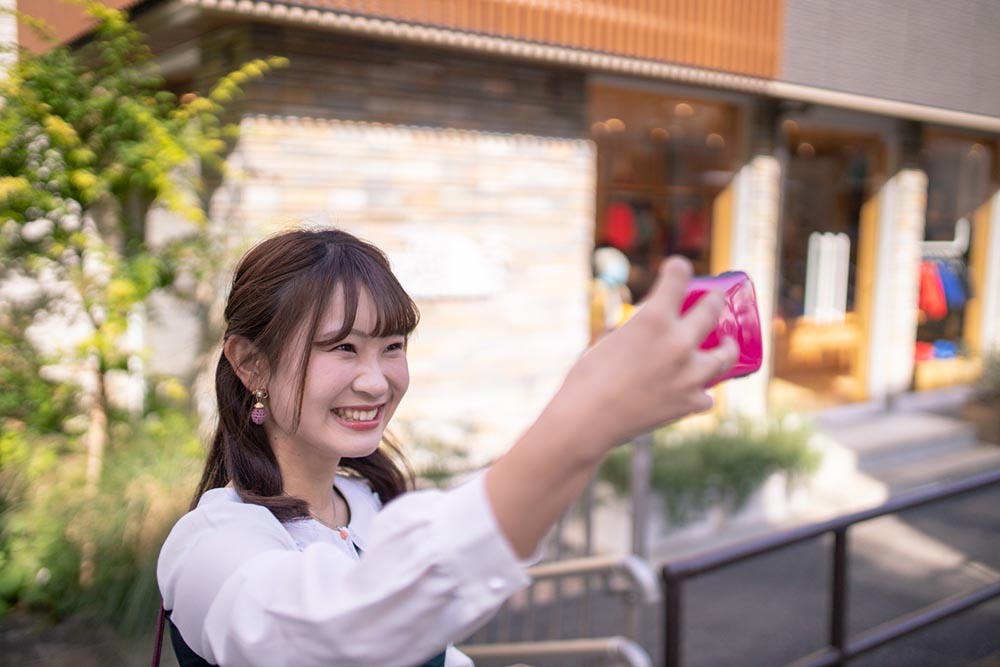Self-Governed Visibility: Japanese Women on TikTok
The visual language of the Japanese Internet remediates previous practices of photo-taking, selfies, and costume play, while users strive to camouflage certain aspects of their private selves. I suggest the concept of self-governed visibility to capture users’ practices of navigating between complete visual anonymity and self-promotion, which often includes their effort to consistently post, interact, and garner followers while pivoting and being in disguise. There is no conventional separation of private and public space on TikTok, as users’ practices show they can simultaneously conceal and promote or over-share aspects of the self. Thus, they can also create a way for self-exploration beyond the binaries of public and private.
I argue that the shift in visual language on TikTok entails more agency for young users, especially young women, to explore the visual terrain and video formats creatively and autonomously, experimenting with the movable concept of identity. TikTok allows young Japanese women to find new forms of self-expression through anonymity, manipulation, and hyperbolic self-promotion while manoeuvring how their bodies and identities are represented. These self-governing practices present the next step in a well-established Japanese girl culture, as seen in how young women utilise the platform to assert individuality and publicly empower themselves. They do so by crafting their narratives while, at the same time, critiquing and challenging gender stereotypes and norms.
At the same time, practices aimed at attaining popularity and seeking fame to monetise work require young women to invest time and effort into their online media presence, and to leverage platform features to pick up new viral trends. The labour young women invest in developing their digital DIY careers, which promise creativity, autonomy, and self-expression, is often misrecognised as leisure and exploited by these platforms.
Self-promotion
The defining feature of TikTok is the algorithmically curated For You page, which shapes how content is discovered based on users’ previous engagements and activity on the app. Scholars Aparajita Bhandari and Sara Bimo suggest the term algorithmised self to explain how the algorithm presents users with access to content that “reflects their interests, likes, and personality, and which might be seen as a curated collection representing their inner ‘self.’” Through the personalised For You page algorithm, central to their experience of the platform, users engage with versions of their identities, thus presenting a new idea of the self and modes of sociality on the app.

Fig. 1: Japanese young
women on the street
taking photos.
In addition to the individually customised video feed, For You’s algorithm impacts how users’ videos achieve virality. Users look for various ways to engage with TikTok’s algorithms which can support recognition and fame-seeking, thus opening the possibility of becoming ‘TikTok famous.’ The most common user practices to ensure visibility are likes, comments, and shares, as well as specific algorithm-related hashtags such as #fyp, #foryou, and viral trends. In this way, users’ self-fashioning practices are heavily guided by the algorithm and users’ desire to be ‘seen’ and validated on the platform.
Young women playfully express themselves with the aim of developing a social media following as an influencer, which entails replicable and normative practices on the platform. One of the most prominent hashtags that reflects users’ active role in interacting with the algorithm is # おすすめ. This is a shortened version of おすすめのりたい [“I want to be recommended as featured video”] and is aimed at garnering followers and increasing the content’s visibility. In most videos, users showcase skills such as singing and dancing. Often, they also request feedback, indicating users’ desire for validation by, and dependence on, other users for affirmation and content visibility. The features of duetting (side-by-side response to existing video), stitching viral videos (clipping and integrating scenes from existing video into one’s own), creating memes, or joining trending challenges represent forms of engagement on TikTok that can enhance the visibility of a user’s content.
One notable example is a 19-year-old person under the pseudonym Kiyomi who uses TikTok to promote her original songs and covers of popular Japanese songs. Interestingly, this user relies on a plain background and expression, despite the abundant effects and filters that the platform offers. She employs various other tactics to attain visibility. In almost all videos, the user engages in ‘algorithmic practices,’ patterned actions intended to drive up the engagement and help monetise her online performance. The most prominent is using the ‘please recommend’ hashtag or seeking attribution and acknowledgment from other users on the songs she has made (e.g., “please duet this video” or “please use this song”). This visual language that involves users’ time and effort to employ different strategies to become noticed and prominent on the platform, including engaging with the algorithm, can be seen as a new form of self-expression in these short-video format platforms – an algorithmic fame-seeking self.
Elevation of the self
AI manga filter is a micro trend on TikTok that shows users transform into manga characters. Unlike other effects on the app that are applied to users’ videos to add flair and customise the individual’s face, body, or backdrop, the AI manga filter generates a cartoon version of the image. It prompts users to experiment with AI to achieve their desired manga portrait. This entails a challenge for users as they compete to produce the most elevated version of the self. Some observed practices include users who play with AI filters to achieve overly emphasised body attributes, such as young women placing toilet paper rolls or bowls on their chests to get large breasts or men holding an egg carton or bread buns to make AI generate abs and a ‘masculine’ body.

Fig. 2: Japanese high school
girl on the train.
These are shared as hacks for tricking AI into generating an ‘idealised’ image and creating content that is intentionally meant to be mimicked and replicated. The trend shows that users strive to fit into prescribed formats of self-presentation to achieve visibility on the platform. However, these playful practices can be read as users’ emphasis on the societal bias that the AI filter perpetuates by over-sexualising users’ bodies, altering their physical features and appearance, and presenting them as conventionally desirable. Young women intentionally mock big breasts through exaggerated displays to reclaim agency and critique compulsory feminine looks and bodies. Similar instances are found among Japanese young women who used ‘eropuri’ or erotic photos in purikura (photo booths) to denaturalise sexualised presentation through overtly sexual appearance and manipulation of erotic conventions.
Self-concealment
Interestingly, the self-fashioning practices originating from purikura culture are also used for self-concealment and obscuring one’s identity. In some cases, we see how modification and manipulation of facial and bodily features obscure young women’s physical characteristics and identity. In this way, enlarged eyes, blurriness, and brightened faces, combined with other visual features and effects, give users control over aspects of personality they want to present to their audience. ‘Self as decoration’ serves not only to facilitate self-expression through aesthetics, but also to conceal actual identities and make users unknown to the audience. Fabrication and camouflage of one’s private or true self can be seen as a way of enabling young women to participate in the culture of public visibility on their terms, especially considering TikTok’s emphasis on visuality.

Fig. 3: Japanese girl
taking a selfie.
In Japanese virtual space, anonymising and concealing one’s appearance is considered an ordinary and culturally situated practice. Similarly, in TikTok, young women employ different techniques of concealing certain aspects of their identities, using costumes and masks, incorporating cute visual elements, blurring the face or image, avoiding close-ups through certain compositional arrangements, and obscuring one’s voice, supported by the centrality of sound effects and lip-syncing on TikTok. Through different strategies to self-disguise and deliberately camouflage their identity, these young women engage in self-fashioning and create an online persona with agency and reality.
However, girls’ anonymity practices are not absolute, and they pick and choose the level of anonymity they want to present as part of self-governed visibility. This is contingent on users’ choices of how much of their ‘actual’ self they want to share on the app. Japanese TikTok and its visual language entail young women’s desire to be seen and validated on the platform, as seen in their intentional self-staging to navigate the platform’s algorithmic recommender system and various tactics of boosting visibility. Alongside its potential to support young women’s creative self-fashioning practices, TikTok is directing identity practices in ways that are profitable to the platform. Often, these practices are characterised by the quantified, standardised presentation of the self, driven by aspirations for social and economic capital.
Although TikTok allows young women in Japan to be creative and embrace their self-expression, the app prioritises conventional and normative ideas of the self and lures users to rework aspects of identities to fit within the standardised frameworks of social identities. Additionally, given their vulnerable role in the Japanese digital economy, young women have a special position in the shift to immaterial forms of labour. Their work and practices in the online space should not be reduced to frivolous self-promotion; rather, they represent a career and novel form of labour that often has exploitative aspects. My study finds that the visual language of Japanese TikTok entails the duality of discrete self-presenting under the veil of anonymity and users’ desire to attract social currency through replicable and viral trends. All of this is observed as a gendered phenomenon and a continuation of young women’s playful use of language via adopting new technology.
Sonja Petrovic is Lecturer/Senior Tutor (Media & Communication) in the School of Culture and Communication, The University of Melbourne. Email: sonja.petrovic@unimelb.edu.au
This article is a shortened version of an article originally published by Melbourne Asia Review, Asia Institute, University of Melbourne.